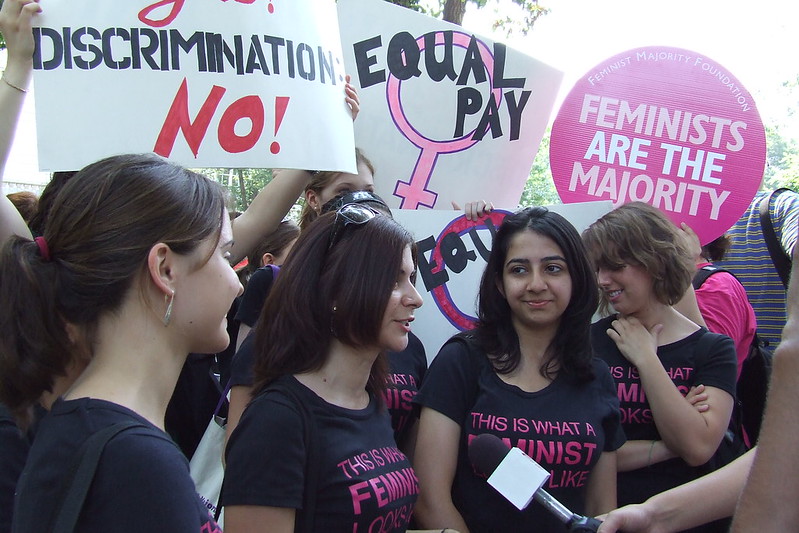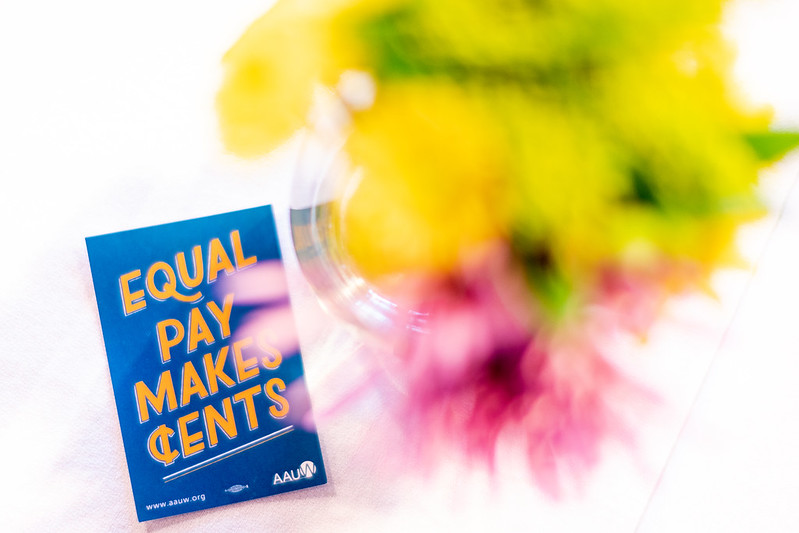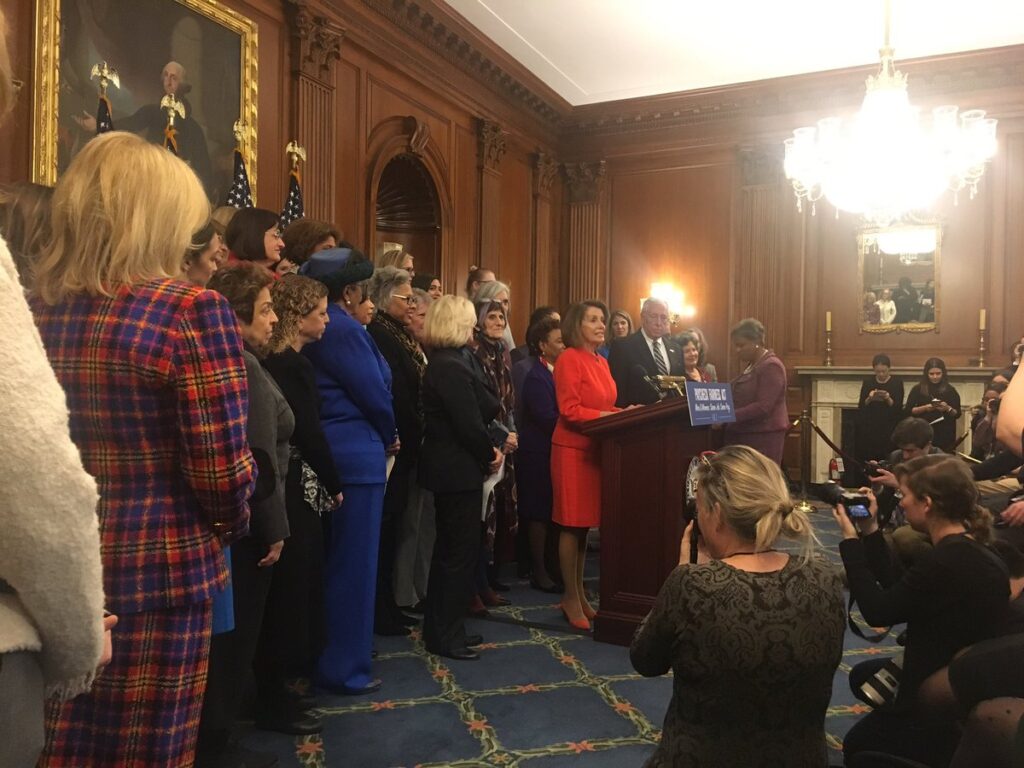
It’s just days until Election Day, and women’s votes are more crucial this year than ever. We must have not only the will, but also a firm grasp of what we need to hold candidates at all levels accountable for policies that work toward social justice and equity for women.
What’s at Stake is a new bi-weekly series of abbreviated excepts from Ms. money editor Martha Burk’s book “Your Voice, Your Vote 2020-2021.” Using an intersectional approach of gender, race and class to issues ranging from health care to Social Security, violence, pay equity, LGBTQ rights, reproductive rights, the ERA and everything in between, Your Voice, Your Vote is a must for arming activists with the facts for meaningful change. A signed copy benefiting Ms. can be ordered here.
The pay gap between working women and men is one of the highest ranking concerns for women. It’s increasingly a priority for men—because when one earner in a family brings in less than she should, the family suffers overall.
Though “equal pay for equal work” has been the law since 1963, disparities in pay for full-time, year-round work are not lessening substantially, and cannot be expected to go away naturally, as some conservatives claim (after all, it’s already been 57 years).
Earnings for women of color continue to be lower than those for white women, who earn 79 percent of men’s wages overall.
- Asian American women make 90 percent.
- African American women come in at 62 percent of men’s earnings.
- For Native American women the percentage is 57 cents.
- Latinas are at the bottom with only 54 percent.
- Moms overall make 69 percent.
The COVID-19 pandemic will have a lasting effect on the pay gap, since more women have been forced to drop out of the workforce. According to a study by the Institute for Women’s Policy Research, a woman who takes off for a single year will likely never catch up, earning less for up to 15 years after she returns to the workforce.
Some Causes of the Pay Gap
- Job segregation. Women are segregated into lower paying clerical and service jobs, males dominate higher paying blue collar, management and technical jobs.
- Devaluation. “Women’s jobs” are still seen by society as less valuable than “men’s jobs,” though requiring the same level of expertise (e.g. social worker vs. parole officer).
- The pay gap itself. If someone must take off work to take care of a child or elderly parent in a two–earner family, economics compels the lower earner (woman) to do it. Single parents (overwhelmingly female) may be forced onto public assistance. Both will fall behind, damaging opportunities for advancement and higher pay.
There have been many studies of the gender pay gap. Even in job titles dominated by women such as teaching and nursing, men in those fields make more. When motherhood and other factors such as age, education and experience are accounted for statistically, there is still a pay gap.
Experts agree: Sex discrimination is the only logical explanation.
Court Battles to Close the Gap
The U.S. Supreme Court’s most important recent pay equity decisions demonstrated a bias in favor of corporations against women.

In a truly bizarre ruling (Ledbetter v. Goodyear, 2007), the Court said that a woman experiencing unequal pay must file a complaint within 180 days after the first instance of discrimination occurs, even if it had gone on for years before she found out about it. Prior rulings had given women 180 days to bring action from the time they learned about the discrimination.
The Ledbetter case galvanized women’s groups and members of Congress to try and overcome the ruling. The Ledbetter Fair Pay Act, restoring the original intent of law as it had been interpreted for nearly 43 years, passed in 2009. Far from being an easy or quick fix, this was only possible after to two years of advocacy and lobbying, an increase in the Democratic majority in both houses of Congress, and a new president who supported its passage.
While the statute will help women in bringing legal action, it will do nothing to prevent wage discrimination in the first place—it just gets us back to where we were over 50 years ago.
In another landmark decision in 2010, the Supreme Court ruled in Dukes v. Walmart that although women in the company may have been denied pay and promotions because of their gender, they could not sue as a class since they came from different parts of the country and different stores. The Court also ruled that discrimination by individual store managers (though documented) was irrelevant. Only the company-wide written anti-discrimination policy counted.
The decision has already had wide–ranging consequences, with many class action suits being thrown out by lower courts, citing Dukes. Without being part of a class, individual workers can’t afford lawsuits, and are much more likely to experience retaliation for complaining.
Legislation to Close the Pay Gap
Comparable worth laws prohibiting discrimination in jobs requiring equal levels of skill, effort, responsibility and working conditions, even if the job titles and duties are different, have been used successfully to narrow the gender wage gap in Ontario, Canada and state of Minnesota (public employees only).
A comparable worth bill was introduced by Sen. Tom Harkin (D–Iowa) in every Congress from the mid–1990s until his retirement in 2013, when the bill disappeared with no action.
Another bill pending on Capitol Hill since the mid ‘90s called the Paycheck Fairness Act finally passed the House in 2019. It prohibits employers from using salary history to set pay and requires them to prove that pay disparities between men and women are a business necessity.

A new minimum wage law would also help greatly, as low minimum wages contribute substantially to the pay gap. Adult women are the largest group earning the minimum wage, Fifty–nine percent of workers who received the last (2009) increase to the current rate of $7.25 were women. Over 1.25 million single parents (mostly women) with children under 18 benefitted. The numbers would be even higher now.
In 2019, the Democratic-held House passed a bill raising the minimum wage gradually to $15 by 2025.
These bills have zero chance of becoming law before the election, since Senate Majority Leader Mitch McConnell (R-Ky.) has no plans for Senate votes, and in any case President Trump has said he would veto raising the minimum it if it passed.
The Last Word on Equal Pay
Even if new laws are passed, the fight won’t be over. With the Supreme Court already having narrowed women’s options in fighting pay discrimination, the choices in future elections and Court appointments become extremely important for passing stronger legislation and for safeguarding women from decisions that will further erode the few remedies available.
Questions for Legislators and Candidates on Pay Equity
- Do you support disclosure of pay statistics by gender, race and job category? For all businesses? For businesses accepting taxpayer dollars?
- Do you support making it unlawful to ask a prospective employee for salary history or to seek that history from another source?
- Do you support raising the minimum wage, and indexing it for inflation?
You may also like:





